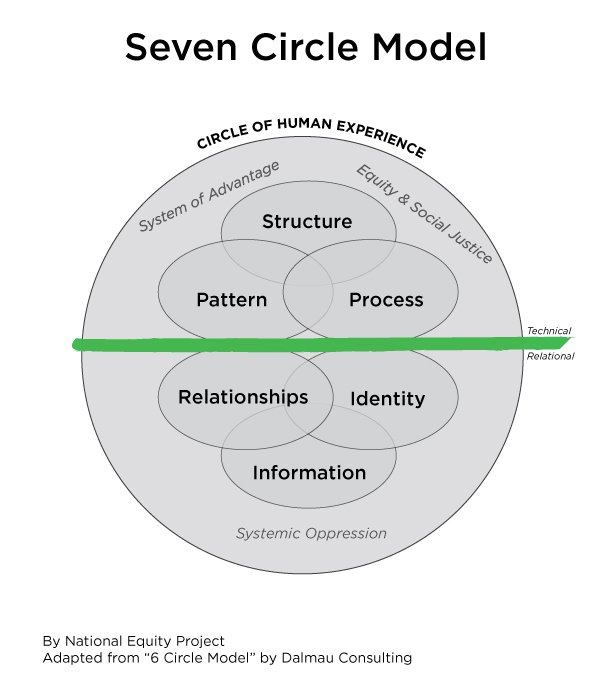Six/Seven Circle Model
“The “hallucination” was that if you changed the structure of the organization - assigned people to have the primary responsibility for a key initiative - the organization would then respond to the change. Additionally, the thinking was that if you designed explicit processes that detailed out every step of a change process, people would willingly respond and create the desired change.
- Steve Zuiback and Tim Dalmau
[Image Description: Title: “Seven Circle Model.” Subtitle: “Circle of Human Experience.”
A large gray circle encompasses six smaller circles labeled with the factors that influence our work for equity. The six circles are divided by a green line which designates the separation between the technical and relational aspects of equity work.
The top half of the circle is dedicated to the technical aspect. It contains two phrases, “systems of advantage” and “equity & social justice.” Beneath those phrases are three circles labeled, “Structure,” “Pattern,” and “Process.”
The bottom half of the circle is dedicated to the relational aspect. It contains three circles labeled, “Relationships,” “Identity", and “Information.”]
Often our view of the issues we are working on are clouded. We can feel like we are on the dance floor in the middle of the crowd, caught in a certain flow and unable to see much more than the things that are immediately in front of us. The 6/7 Circle Model provides a way for us to get out of the thick of things and perceive issues more clearly. It is akin to getting up on the balcony; it serves as a way to think through different factors that influence our work. This model can be used as both a conceptual frame and diagnostic tool to design or advance your equity work.
The Six Circle Model (also referred to as “Above / Below the Green Line”) was developed by Margaret Wheatley and Dalmau Consulting. The inner six circles are divided into two broad categories: technical and relational. Typically, our work (influenced by white/western cultural axiology) focuses on technical aspects: Structure, Pattern and Process. While these aspects of work are crucial, they can feel cold and ignore the human element of our work.
We emphasize the importance of paying attention to the often neglected relational aspects “below the green line”: Relationships, Identity and Information. Being attentive to these factors allows us to account for the social and cultural nature of equity work.
The addition of the 7th Circle encompasses all six of the inner circles while turning our attention towards the conditions of oppression that our work exists within. We must take a step back to get an accurate view of what is happening around us; pay attention to history and trajectory, as well as systems of dominance and oppression.
Some questions to inform your use of the Seventh Circle:
Who are the people affected by the current inequity being discussed?
What historical patterns (around race, class, language, etc.) may be informing the dynamics in this context?
Who has power here? What is power based on here? Who is at the table?
How are oppression, internalized oppression and transferred oppression playing out right here, right now? (In this school, in this group, in this organization, in this district?)
How safe is it here for different people to share their truth?
What are the potential unintended consequences of our proposed solutions/actions? Do the proposed solutions ignore or worsen existing disparities for the group in which we are focused?
References
Dalmau Consulting. (2016). “Six Circle Model”. http://www.dalmau.com/six-circle-model/
Zuieback, Steve. (n.d.). “ Below the Green Line or the 6 Circle Model: Putting Theory into Practice”.

